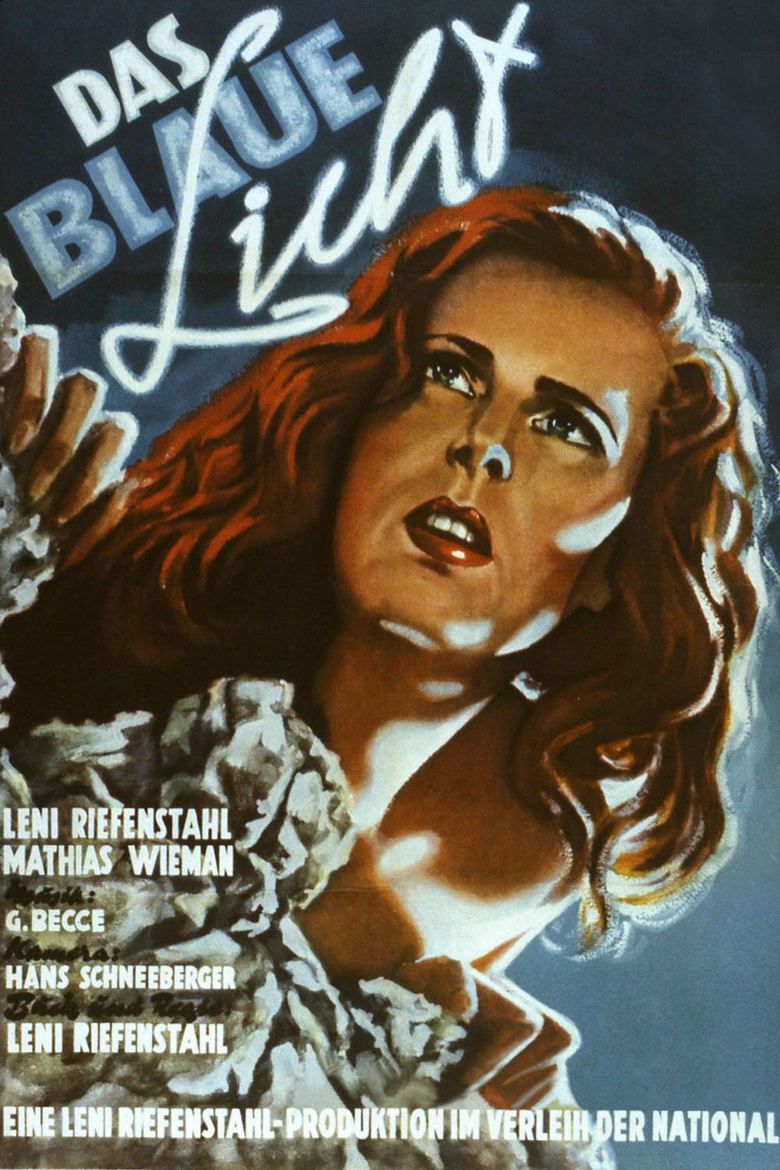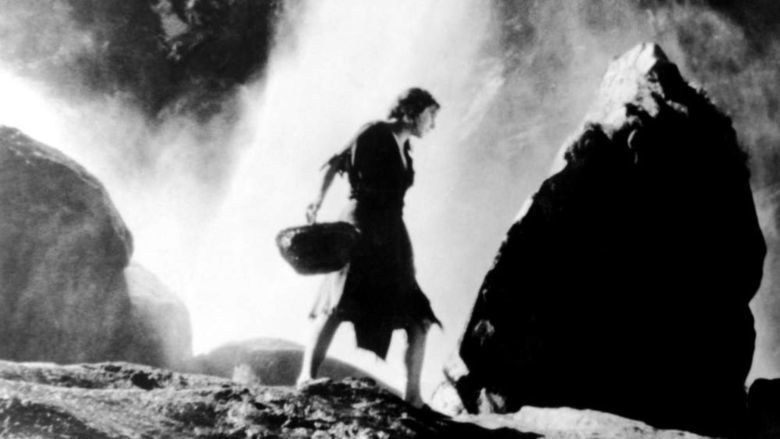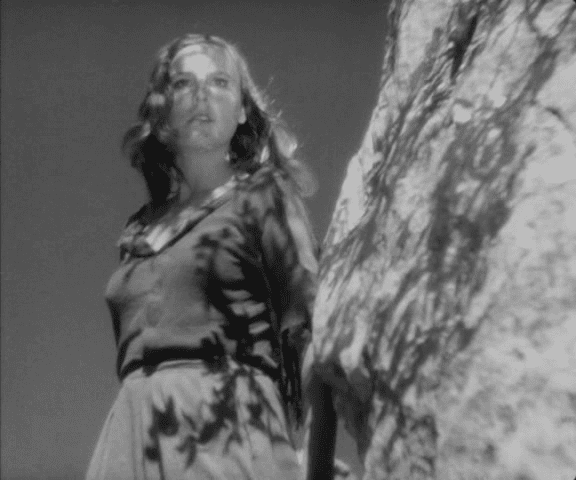The Blue Light (1932 film)
5 /10 3 Votes7
Duration Country Germany | 7/10 IMDb Genre Drama, Fantasy, Mystery | |||||||||||||||||||||||||||||||||
 | ||||||||||||||||||||||||||||||||||
Release date 24 March 1932 (1932-03-24) (Berlin)8 May 1934 (1934-05-08) (USA) Cast Similar movies Leni Riefenstahl directed The Blue Light and appears in SOS ICEBERG - SOS EISBERG | ||||||||||||||||||||||||||||||||||
The Blue Light (German: Das blaue Licht) is a black-and-white 1932 film written and directed by Leni Riefenstahl and Béla Balázs, with uncredited scripting by Carl Mayer. In Riefenstahl's film version, the witch, Junta, played by Riefenstahl, is intended to be a sympathetic character. Filming took place in the Brenta Dolomites, in Ticino, Switzerland, and Sarntal, Italy.
Contents
- Plot summary
- Cast in credits order
- Production background
- Reception
- Re release
- Possible inspirations
- References

Plot summary

A young woman, Junta (Riefenstahl), lives apart from her village and, for her solitude and strangeness, is considered to be a witch; when she comes to the village for one reason or another, the townsfolk chase her away. They feel that she may in some way be responsible for the deaths of several young men of the village, who have felt compelled, one by one, to climb the local mountain (and fall to their deaths) on nights when the moon is full.

Junta lives largely in solitude (except for the company of a young shepherd boy) in the tranquility of the mountains surrounding the village. She plays in the hills and woodlands, as a naive, free spirit. She is simple and innocent, but also seems something of a mystic. She loves to climb and clamber over the steep, difficult faces of local mountains.

On full moon nights, a crack in a prominent local mountain admits the moon's light and illuminates a grotto filled with beautiful crystals. This place of indescribable beauty, glowing with magical blue light, is a sacred space for Junta. The glowing blue light, shining from afar, to the village below, is also what has attracted the village's young men, none of whom ever reached it before falling off the mountain's treacherous slope.
A man from the city, a painter, traveling through the village, falls in love with Junta. He follows her to the cabin she shares with the shepherd boy, and decides to stay for a while. The man speaks only German, and Junta only Italian, so their communication is fragmentary. All is pleasant and good and very chaste, until the next full moon night, when the man sees Junta climbing up the mountain. He follows her, actually reaching the beautiful grotto, and finds Junta in a state of ecstasy among the crystals.
Perceiving these thousands of crystals to be a source of immense wealth for Junta and the villagers, the man immediately runs down to inform the townsfolk and tells them of the correct route to reach the grotto. Junta does not realize that he is doing this, until the next day, when she finds some of her crystals on the path to the village, as well as some dropped tools. Rushing up to the grotto, she finds it completely barren of crystals: all have been taken by the greedy villagers. Meanwhile, the villagers and the painter are celebrating. Junta is totally devastated at this violation of the sacred grotto and of her trust in the outsider and falls to her death.
Cast (in credits order)

Production background
In the 1993 documentary The Wonderful, Horrible Life of Leni Riefenstahl (1993), Riefenstahl relates that the Agfa Film Corporation gave her a new film stock called R-Stock. When filming was done through a red filter the sky would appear absolutely black. The film was among the first sound films to be filmed entirely on location.
Arnold Fanck, who had directed several mountain films featuring Riefenstahl, did a first edit of the film, which Riefenstahl found unacceptable, and she completely re-edited the film.
Reception
The film was a moderate commercial and critical success. It performed well in much of Europe and the UK, although some critics were divided, particularly in Germany. Several left wing news publications derided the effort, while it was applauded by the right wing press. The film enjoyed considerable commercial and critical success in London and Paris, where Alpine cinema was a novelty.
The New York Sun described the film as "one of the most pictorially beautiful films of the year. Leni Riefenstahl - author, director and star - is an expert climber as well as handsome woman."
The New York Herald Tribune praised the "sheer pictorial beauty", the publication also praised Riefenstahl remarking "how flawlessly this girl, who plays the lead and also wrote and directed, accomplished her task."
The New York Times remarked that "a summary of the story gives no adequate idea of the beauty of the action and the remarkable camera work, especially in connection with the light effects."
The film's aesthetic, particularly the depiction of nature, is also said to have caught the attention of Adolf Hitler, and possibly contributed to his later decision to commission Riefenstahl to make propaganda films for him.
Re-release
In 1937, a re-release of the film removed the names of Mayer, Balázs, and Sokal, since they were Jews.
An edited version of the film was released in 1951, funded by Italian corporations. Riefenstahl edited the film from 86 to 73 minutes, removing the arrival scene of modern urbanites in Santa Maria. The film was marketed with the credit "A Mountain Legend by Leni Riefenstahl". In November 1951, It premiered with a new edit, score and soundtrack in Rome at a gala screening that Riefenstahl described as "dazzling". The film was distributed in German cinemas and had a limited release in Austria under the title The Witch of Santa Maria (Die Hexe von Santa Maria).
Possible inspirations
A similarly named legend in Germany (Das blaue Licht) may have lent some inspiration to Riefenstahl's screenplay. In a period of time when a pan-Germanic ethos was sweeping the country, audiences were highly likely to have been familiar with the old legend, and accordingly expected the film to follow it closely. However, the film shares very little with the legend, and even departs from it in an unexpected way, casting Leni Riefenstahl as the beautiful loner, not at all a witch, but wrongly accused of being one.
The original legend, compiled by the Brothers Grimm in 1810, and later popularized by the pre-Hitler nationalists of the 1920s, tells the story of a crippled soldier who is terminated from the service of his king. Released from service, he travels into the woods to seek a cure, and comes upon a witch's house. It is there that he asks her if she is willing to help him. She agrees to cure him but he must first do three things for her. (The third task being nothing less than to descend into a very deep and dry well, and bring back from its depths a magic lamp.)
In that legend, however, the soldier finds a dwarflike creature at the bottom of the well. Apart from the strange lamp he comes upon, which glows in a mysteriously blue light (and which ultimately leads to the witch's ruin), there is very little else to connect Riefenstahl's concept to the German myth that came before her.
Gustav Renker's novel Bergkristall (1930) has many similarities to the plot of Das blaue Licht and may have been used by Balázs and Riefenstahl without attribution.
References
The Blue Light (1932 film) WikipediaDas Blaue Licht IMDbThe Blue Light (1932 film) themoviedb.org
